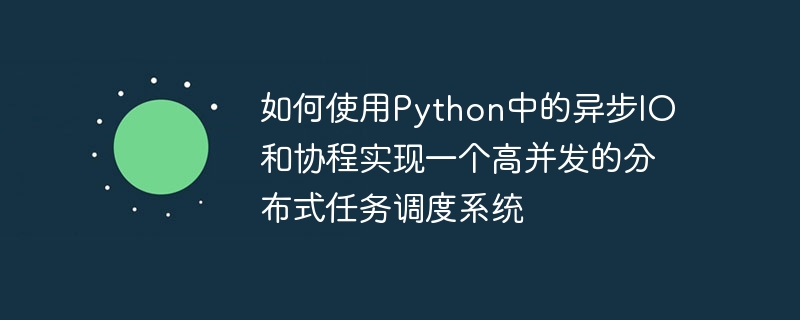

How to use asynchronous IO and coroutines in Python to implement a highly concurrent distributed task scheduling system
In today's rapidly developing information age, distributed systems have become become more and more common. High-concurrency task scheduling systems have also become an indispensable part of many enterprises and organizations. This article takes Python as an example to introduce how to use asynchronous IO and coroutines to implement a highly concurrent distributed task scheduling system.
Distributed task scheduling systems usually include the following basic components:
In order to achieve high concurrency, we use asynchronous IO and coroutines to build a distributed task scheduling system. First, we choose a suitable asynchronous IO framework, such as asyncio in Python. Then, collaboration between different components is achieved by defining coroutine functions.
In the task scheduler, we can use coroutines to handle task distribution and monitoring. The following is a simple sample code:
import asyncio
async def task_scheduler(tasks):
while tasks:
task = tasks.pop()
# 将任务发送给执行节点
result = await execute_task(task)
# 处理任务的执行结果
process_result(result)
async def execute_task(task):
# 在这里执行具体的任务逻辑
pass
def process_result(result):
# 在这里处理任务的执行结果
pass
if __name__ == '__main__':
tasks = ['task1', 'task2', 'task3']
loop = asyncio.get_event_loop()
loop.run_until_complete(task_scheduler(tasks))In the execution node, we can use coroutines to receive tasks and execute them. Here is a simple sample code:
import asyncio
async def task_executor():
while True:
task = await receive_task()
# 执行任务的具体逻辑
result = await execute_task(task)
# 将任务执行结果发送回任务结果队列
await send_result(result)
async def receive_task():
# 在这里接收任务
pass
async def execute_task(task):
# 在这里执行具体的任务逻辑
pass
async def send_result(result):
# 在这里发送任务执行结果
pass
if __name__ == '__main__':
loop = asyncio.get_event_loop()
loop.run_until_complete(task_executor()) In the above sample code, asyncio provides the async and await keywords for Define coroutine functions and wait for the execution results of other coroutines in the coroutine. By defining the task processing logic in the task scheduler and execution nodes as coroutine functions, we can take advantage of the characteristics of asynchronous IO and coroutines to implement a highly concurrent distributed task scheduling system.
In addition to task schedulers and execution nodes, task queues and task result queues can also be implemented using coroutines. For example, using asyncio.Queue as the task queue and result queue can easily implement asynchronous task scheduling and result processing.
To sum up, by using asynchronous IO and coroutines in Python, we can easily implement a highly concurrent distributed task scheduling system. This approach not only improves the performance and scalability of the system, but also makes better use of system resources. Of course, the above example code is just a simple example. In an actual distributed task scheduling system, more factors may need to be considered, such as network communication and load balancing. But by mastering the basic principles and applications of asynchronous IO and coroutines, we can better understand and build more complex distributed systems.
The above is the detailed content of How to use asynchronous IO and coroutines in Python to implement a highly concurrent distributed task scheduling system. For more information, please follow other related articles on the PHP Chinese website!




